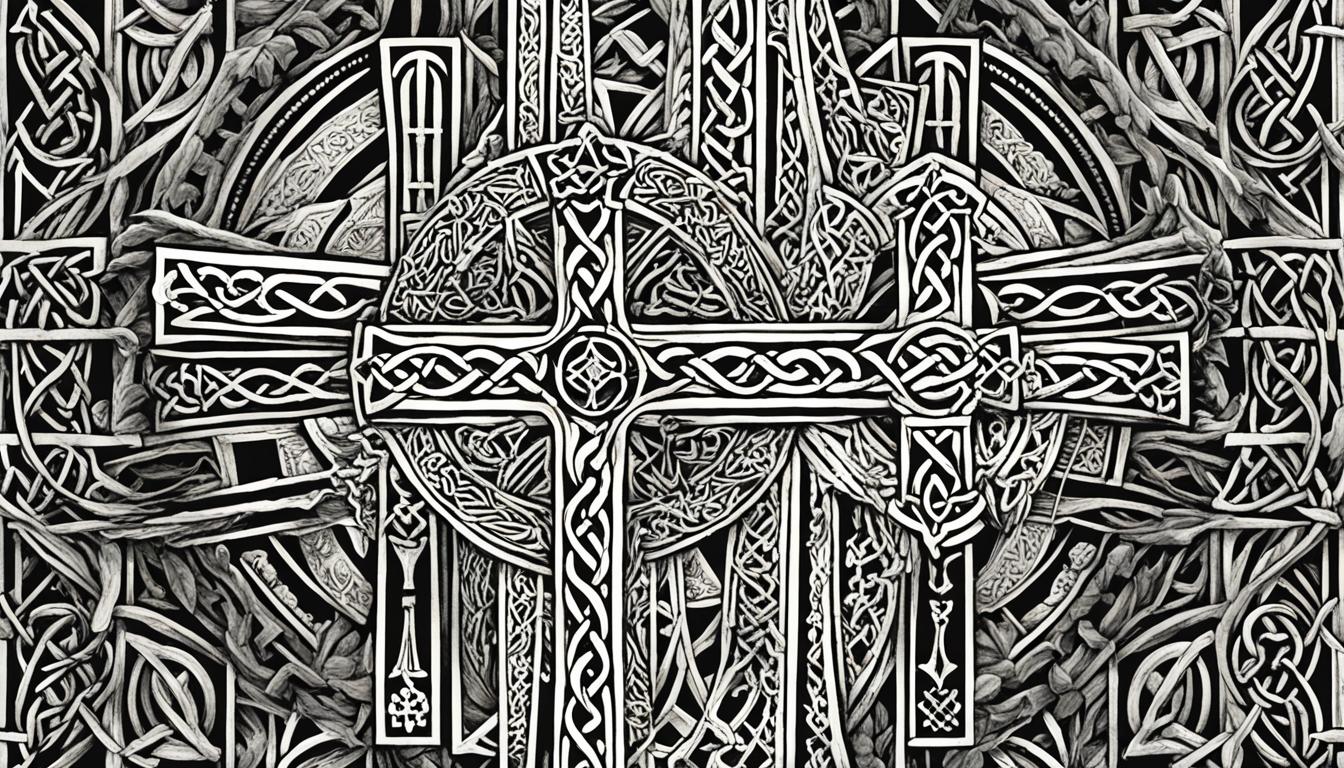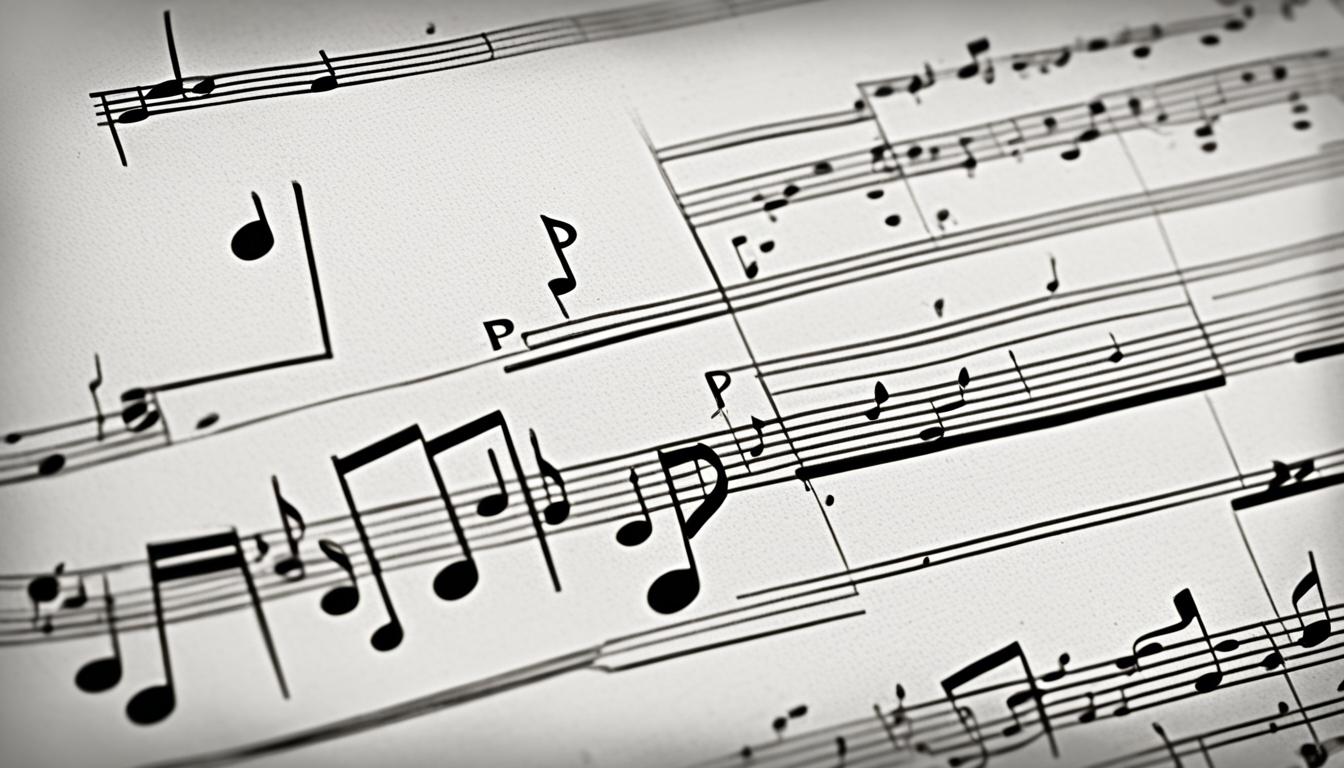Can you believe crosses have been **important symbols** for thousands of years across many cultures and religions? They carry deep meanings and have rich, diverse **significance**.
In this article, we will delve into the cultural and spiritual significance of crosses and their meanings. We will explore the ancient symbols and modern religious iconography related to crosses, highlighting the deep religious symbolism and the various interpretations of this powerful symbol.
Key Takeaways:
- Crosses have been used as symbols for thousands of years in various cultures and religions.
- Crosses hold deep cultural and spiritual significance.
- There are diverse meanings associated with crosses, ranging from sacrifice and transcendence to love and heroism.
- Understanding the symbolism of crosses can provide insights into religious traditions and deepen our understanding of various cultures.
- We will explore different types of crosses, their designs, and their cultural interpretations.
The Cross: A Symbol Transcending Time and Culture
The cross is an ancient symbol that has transcended time and culture, holding profound significance throughout human history. Dating back to pre-Christian times, the cross has been found in ancient cave art, showcasing its enduring presence and universal appeal. This section will explore the diverse types of crosses, cultural interpretations of their meaning, and the rich history of cross symbolism.
Types of Crosses
There are numerous types of crosses, each with its own unique design and symbolism. Let’s take a closer look at a few of the most well-known types:
| Type of Cross | Description | Symbolism |
|---|---|---|
| Latin Cross | A simple upright cross with a shorter horizontal beam near the top. | A symbol of Christianity and Christ’s sacrifice. |
| Celtic Cross | A cross with a circle intersecting the vertical and horizontal beams. | Combines Christian and Celtic traditions, representing eternal life and the intersection of the physical and spiritual realms. |
| Coptic Cross | A cross with a loop at the top, resembling an ankh cross. | A symbol of the Coptic Orthodox Church and the union of divinity and humanity in Christ. |
These are just a few examples of the diverse range of cross designs and their cultural interpretations. The significance of crosses extends far beyond their visual representation, encompassing religious, spiritual, and symbolic connotations.
Cultural Interpretations of Crosses
“The cross has a multitude of meanings across different cultures and traditions. It serves as a powerful symbol that bridges the gap between the earthly and spiritual realms.”
Throughout history, the cross has been interpreted in various ways by different cultures and religious traditions. In Christianity, it represents the crucifixion and resurrection of Jesus Christ, embodying themes of sacrifice, redemption, and eternal life. In other cultures, the cross has been associated with concepts such as fertility, the sun, and the four elements.
An example of cultural interpretation can be observed in ancient Egyptian hieroglyphs, which depict the “ankh” symbol resembling a cross with a loop at the top. The ankh symbolized life and immortality in the Egyptian belief system, illustrating how crosses can hold different meanings and interpretations in diverse cultural contexts.
History of Cross Symbolism
“The history of cross symbolism dates back thousands of years, with evidence of its presence in various ancient civilizations and religious practices.”
The cross’s symbolism predates Christianity and can be traced back to prehistoric times. It has been found in rock art and artifacts dating back thousands of years, showcasing its enduring presence in human consciousness. In ancient civilizations such as the Aztecs, Mayans, and Greeks, crosses held cultural, religious, and spiritual significance.
One of the most well-known historical uses of the cross is the Roman crucifixion, a form of execution that involved the victim being nailed to a cross-shaped structure. This method of punishment emphasizes the cross’s association with suffering, sacrifice, and martyrdom.
Furthermore, the cross became an important symbol in the spread of Christianity, as it represented the transformative power of Jesus Christ’s death and resurrection. Over time, the cross developed into a central motif in Christian art, architecture, and religious iconography.
The Transcendent Power of the Cross
“Regardless of cultural interpretations or historical contexts, the cross remains a symbol that transcends time and culture, resonating with people across different faiths and backgrounds.”
Whether it’s the Latin cross in Christianity, the ankh in ancient Egypt, or other cross variations, the symbol continues to evoke powerful emotions and spiritual connections. It represents a bridge between the mundane and the divine, serving as a reminder of our shared human experience and the possibility of transformation.
As we explore the significance of crosses in different cultures and throughout history, we gain a deeper understanding of the diverse interpretations and meanings associated with this timeless symbol.
The Cross as a Point of Transcendence
The cross, a powerful symbol deeply ingrained in human history, holds spiritual meanings that reach beyond the physical realm. It represents a point of transcendence between the earthly plane and spiritual/mystical experience. In exploring the spiritual significance of crosses, we uncover a tapestry of diverse interpretations and symbolisms.
Throughout history, cross designs have evolved and manifested across various cultures and religious traditions. The intricacies of cross iconography serve to amplify its transcendental message.
Cross Designs: A Reflection of Spiritual Meanings
There is an array of cross designs, each weaving its own narrative of spirituality and belief. Let us delve into a few notable examples:
| Cross Design | Spiritual Meaning |
|---|---|
| Latin Cross | The most universally recognized cross design, the Latin cross symbolizes the crucifixion of Jesus Christ and the redemptive power of sacrifice in Christianity. |
| Celtic Cross | Combining a traditional cross with a circular ring, the Celtic cross represents the union of the Christian cross with ancient Celtic symbolism, emphasizing the eternal nature of spirituality. |
| Coptic Cross | Hailing from the Coptic Orthodox Church, the Coptic cross showcases a unique design with intricate details and flourishes, signifying the Copts’ rich spiritual heritage. |
The diverse array of cross designs exemplifies the deep connection between form and meaning, as well as the cultural and historical contexts that shape their interpretations.
Interpreting Cross Iconography
Within cross iconography lies a rich tapestry of layered symbolism, encompassing both universal and culturally specific interpretations. The utilization of various elements within cross designs conveys complex narratives:
- The use of colors: Different hues carry symbolic weight, such as red representing sacrifice or purity, blue symbolizing divinity or heavenly realms, and gold embodying divine light or transcendence.
- Decorative embellishments: Intricate patterns, filigree, or gemstone accents add depth to cross iconography, symbolizing the beauty and richness of the spiritual experience.
- Religious figures and motifs: Depictions of saints, angels, or religious scenes serve as visual representations of divine presence and spiritual guidance.
These elements, integrated harmoniously within cross iconography, invite individuals to reflect on and connect with their own spiritual journeys.
The cross, in its myriad designs and iconography, serves as a powerful catalyst for spiritual contemplation, guiding individuals towards higher states of consciousness and connection with the divine.
As we explore the spiritual meanings of crosses and delve into the intricacies of cross designs and iconography, we gain a deeper understanding of the universal human longing for transcendence.

The Cross as a Symbol of Sacrifice
The cross is widely recognized as a symbol of sacrifice, particularly within the context of Christianity. It holds profound religious significance as a representation of Christ’s ultimate sacrifice for humanity. The cross represents not only the physical crucifixion but also the spiritual and emotional endurance of suffering in pursuit of a greater purpose.
Throughout history, the cross has been used as a powerful visual tool to convey the concept of sacrifice. Its universal recognition as a symbol of Christianity amplifies its impact and deepens its religious connotations. The cross is a constant reminder of the selflessness and devotion required to overcome adversity and fulfill one’s higher calling.
The Cross and Its Representation of Christ’s Sacrifice
At the core of Christianity lies the belief in Jesus Christ’s sacrificial act of giving his life on the cross for the redemption of humanity’s sins. The crucifixion represents the ultimate expression of love, mercy, and sacrifice. Through his willing acceptance of suffering, Jesus demonstrated that his love knew no limits.
The cross serves as a poignant reminder of the magnitude of Christ’s sacrifice, inspiring believers to emulate his example in their own lives. It symbolizes the selflessness and dedication required to follow a path of righteousness despite the challenges and hardships faced along the way.
Moreover, the cross is also a tangible representation of the immense love and compassion that God has for humanity. Through the sacrifice of his son, God offers forgiveness, salvation, and eternal life to those who have faith.
As a religious symbol, the cross holds great reverence and serves as a focal point for worship and reflection. It serves as a visual reminder of the divine sacrifice that underpins the Christian faith and encourages believers to live lives of sacrifice, service, and devotion to God and others.
“The cross, representing Christ’s sacrifice, stands as a symbol of the love and compassion that God has for humanity.”
Throughout history, the cross has been employed as a powerful visual symbol in religious art, expressions of devotion, and the ornamentation of religious spaces. It is a constant reminder of the importance of sacrifice in the spiritual journey and the unwavering commitment required to follow one’s faith.
| Cross Symbolism | Significance |
|---|---|
| Cross Represent | The cross represents the sacrifice of Jesus Christ and the love and compassion of God for humanity. |
| Symbol of Christianity | The cross is the central symbol of Christianity, signifying the core beliefs of the faith and serving as a visual representation of Christ’s sacrifice. |
| Cross Used | The cross is widely used in religious rituals, artwork, and religious adornments to symbolize sacrifice and invoke spiritual contemplation. |
| Cross Is Also | In addition to its religious symbolism, the cross is also recognized as a cultural and historical symbol, representing various aspects of human history, art, and social movements. |
| Religious Symbol | As a religious symbol, the cross holds immense significance and serves as a visual representation of faith, sacrifice, and redemption. |
The Cross as a Model of Love and Heroism
The cross, with its historical and cultural significance, serves as a recognized symbol of love and heroism. Throughout history, there have been numerous remarkable individuals who have embodied these qualities, standing for truth, justice, and love, even in the face of adversity. Among these historical figures, Socrates, Gandhi, and Martin Luther King Jr. stand out as exemplars of love and heroism.
Socrates, the renowned Greek philosopher, fearlessly challenged societal norms and the status quo in his pursuit of truth and wisdom. He believed that love of wisdom, or philosophy, was the highest expression of human potential. Despite facing opposition and ultimately being sentenced to death, Socrates willingly made the ultimate sacrifice, remaining steadfast in his commitment to truth and the pursuit of knowledge.
Gandhi, the influential Indian leader, used nonviolent resistance as a means to fight against injustice and oppression. He advocated for love, tolerance, and harmony among individuals and communities. Gandhi’s dedication to truth, peace, and the welfare of others inspired a nation and continues to resonate with people around the world. His relentless pursuit of justice and his unwavering commitment to love and nonviolence make him a true hero.
“Darkness cannot drive out darkness; only light can do that. Hate cannot drive out hate; only love can do that.” – Martin Luther King Jr.
Martin Luther King Jr. was a prominent figure in the American Civil Rights Movement. In his pursuit of racial equality, he preached love, peace, and nonviolent resistance as powerful tools for social change. King’s famous “I Have a Dream” speech continues to inspire generations, reminding us of the transformative power of love and justice. Despite facing adversity and ultimately sacrificing his life for the cause, King’s legacy of love, heroism, and unwavering commitment to the principles of equality and justice continue to inspire people worldwide.
These historical figures, among countless others, have recognized the transformative power of love and the importance of standing up for what is right, even in the face of tremendous challenges. Their actions serve as a testament to the enduring symbol of the cross, which has become synonymous with love and heroism.

The Upside-Down Cross: Controversy and Symbolism
The upside-down cross, also known as the Petrine Cross, holds both controversy and deep spiritual significance. This unique cross is associated with Saint Peter, a prominent figure in Christian history who requested to be crucified upside-down.
Saint Peter’s decision to be crucified in this manner was a reflection of his humility and sense of unworthiness in comparison to Jesus Christ, who was crucified on an upright cross. By choosing this unconventional form of crucifixion, Saint Peter sought to demonstrate his unworthiness of the same death as Jesus, considering himself a lesser figure in religious authority.
“Lay all the world’s religions before me, and the one I would select would be that of Saint Peter, who knew how to bear the reproach of the cross better than any other.” – Johann Wolfgang von Goethe
The upside-down cross has garnered various interpretations and stirred controversy over the centuries. Some view it as a symbol of Satanic worship or anti-Christian sentiment, perceiving it as a tool of rebellion against religious authority. However, it is crucial to understand that the upside-down cross’s true meaning lies in its association with Saint Peter and his humility, rather than any negative connotations.
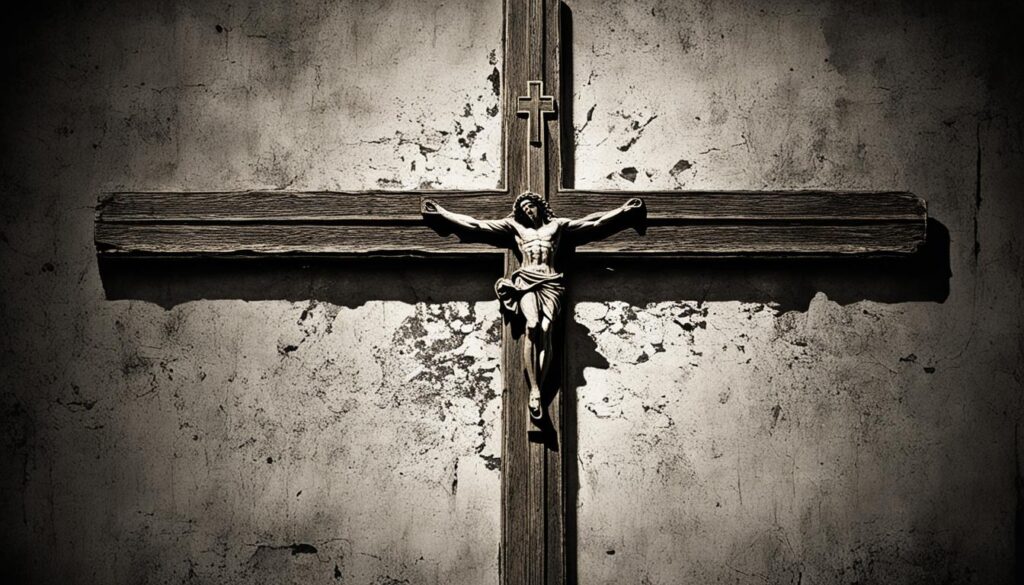
The upside-down cross is often used as a representation of religious authority, challenging conventional norms and highlighting the complexities of faith. It serves as a reminder that religious figures are also human, capable of doubt and imperfection, despite their spiritual authority.
While the traditional, upright cross is widely recognized and symbolizes the sacrifice of Jesus, the upside-down cross represents Saint Peter’s unique journey and his refusal to consider himself equal to Christ. It underscores the extraordinary level of devotion and humility exhibited by this revered apostle.
The Cross as a Symbol of Humility in Christianity
Within Christianity, the cross holds great religious significance, representing a powerful symbol of humility and the acknowledgment of one’s unworthiness before God. It serves as a reminder of Jesus’ sacrifice and the ultimate act of humility demonstrated through his crucifixion.
Throughout the Bible, humility is esteemed as a virtue that Christians should embrace in their lives. Jesus himself set an example of humility through his teachings and actions, emphasizing the importance of putting others before oneself. In Philippians 2:8, it is written, “And being found in human form, he humbled himself by becoming obedient to the point of death, even death on a cross.” This passage highlights the profound humility embodied by Jesus, willingly sacrificing his life for the salvation of humanity.
As the central symbol of Christianity, the cross serves as a visual representation of this humility. Its simple yet powerful design serves as a constant reminder for believers to humble themselves before God and to treat others with kindness and compassion.
“True humility is not thinking less of yourself; it is thinking of yourself less,” said C.S. Lewis, a renowned Christian author and theologian.
The Papacy, as the spiritual leadership of the Roman Catholic Church, has a significant connection to the cross and humility. The Pope, as the head of the Catholic Church, is seen as the successor of Saint Peter, who himself requested to be crucified upside-down, deeming himself unworthy of the same death as Jesus. Saint Peter’s humility and unwavering faith have become synonymous with the Papacy, and the cross serves as a powerful symbol of this humility within the highest authority of the Catholic Church.
By embracing the symbolism of the cross and striving for humility, Christians are reminded of their human limitations and their dependence on a higher power. It calls for genuine introspection and self-reflection, encouraging individuals to humbly submit themselves to God’s will and to live lives marked by humility, compassion, and service to others.

| Papacy and Humility | Key Features | |
|---|---|---|
| 1 | Connection to Saint Peter | The Papacy traces its spiritual authority and lineage back to Saint Peter, who demonstrated humility through his request to be crucified upside-down. This association with humility is symbolized by the cross. |
| 2 | Leadership Example | The Pope, as the leader of the Catholic Church, is seen as an embodiment of humility in his role. His actions and teachings are expected to reflect the humility represented by the cross. |
| 3 | Spiritual Guidance | The cross serves as a reminder for the Pope and all members of the clergy to approach their roles with humility, recognizing their duty to serve and guide believers. |
Overall, the cross holds profound religious significance within Christianity, serving as a symbol of humility and the acknowledgement of one’s unworthiness before God. It represents the ultimate act of sacrifice and calls believers to live lives marked by humility, recognizing the importance of putting others before oneself. The connection between the cross and the Papacy underscores the significance of humility within the highest authority of the Catholic Church, symbolizing the ongoing importance of this virtue within the Christian faith.
Misinterpretations and Misconceptions of the Cross
Despite its sacred origins, the cross has been subjected to numerous misinterpretations and misconceptions throughout history. These misunderstandings often stem from a lack of understanding or intentional misrepresentation of its true meaning. One common misconception is the association of the cross with satanism, which is a misinterpretation of its deep religious significance. It is important to clarify these misconceptions and shed light on the complexities of religious symbols in popular culture.
Addressing Misconceptions
One of the most prevalent misconceptions surrounding the cross is its connection to satanism. Some individuals wrongly assume that the cross symbolizes rebellion against religious authority or anti-Christian sentiment. However, this interpretation is far from the truth. The cross holds a central place in Christianity and represents the ultimate sacrifice and love of Jesus Christ. It is a symbol of faith, not an emblem of satanic worship.
Another misconception is the belief that the cross has a universally negative connotation. While it is true that the cross has been used in various historical contexts as a symbol of oppression or persecution, it is essential to understand that these negative associations are not inherent to the symbol itself. The cross should be viewed in its religious and cultural context to fully appreciate its intended meaning.
Complexities of Religious Symbols
“Symbols are not always what they seem. The true meaning lies beneath the surface, awaiting discovery.”
Religious symbols, including the cross, are intricate and multifaceted. They have the power to evoke deep emotions and represent complex beliefs and traditions. However, symbols are often subject to interpretation and can be misunderstood or misused. It is crucial to approach religious symbols with an open mind, willing to explore their historical and cultural significance.
The cross, in particular, carries different meanings across various religious and cultural contexts. It is a symbol of salvation and love in Christianity, while in other faiths and traditions, it may represent sacrifice, balance, or connection with the divine. Understanding these diverse interpretations helps dispel misconceptions and fosters greater respect for religious symbols.
| Common Misconceptions | Factual Explanation |
|---|---|
| The cross is a symbol of satanism. | The cross is a central symbol in Christianity and represents the ultimate sacrifice of Jesus Christ. It has no inherent connection to satanism. |
| The cross symbolizes rebellion against religious authority. | The cross is a symbol of faith and love in Christianity. It is not intended as a representation of rebellion. |
| The cross has a universally negative connotation. | The cross’s meaning varies across different religious and cultural contexts. Negative associations are not inherent to the symbol itself. |
Examining these misconceptions and understanding the complexities of religious symbols like the cross enables us to appreciate the true depth and significance they hold. By seeking knowledge and embracing cultural diversity, we can foster a more inclusive and informed understanding of religious symbols in popular culture.

Different Types of Crosses and Their Meanings
The cross is a symbol that takes various forms, each with its own unique design and cultural significance. In this section, we will delve into the meanings associated with three popular types of crosses: the Latin cross, Celtic cross, and Coptic cross.
The Latin Cross
The Latin cross is one of the most recognized symbols of Christianity. It consists of a vertical line intersected by a shorter horizontal line near the top. Also known as the Christian cross or the Western cross, the Latin cross is widely used in religious contexts and represents the crucifixion of Jesus Christ.
“The Latin cross serves as a powerful reminder of Christ’s sacrifice and the redemption offered through his death and resurrection.” – Christian Theologian
The symbolism of the Latin cross extends beyond its religious significance. It has also become a universal symbol of hope, faith, and love, embraced by people of various cultures and backgrounds.
The Celtic Cross
The Celtic cross is a cross with a circle intersecting the crossbar. It originated from Celtic culture and is associated with pre-Christian spirituality in Ireland, Scotland, and other Celtic regions. The circle represents the cycle of life, eternity, and the sun, while the cross represents the intersection of the physical and spiritual realms.
“The Celtic cross embodies the harmony between the celestial and earthly realms, serving as a symbol of balance, protection, and spiritual connection.” – Celtic historian
The Celtic cross is often adorned with intricate knotwork and other Celtic designs, reflecting the rich artistic traditions of the Celtic people. It is commonly found in Celtic art, jewelry, and as gravestones in ancient cemeteries.
The Coptic Cross
The Coptic cross is an ancient Christian cross variant used by the Coptic Orthodox Church of Alexandria, Egypt. It features a unique design with a crossbar at the top pointing to heaven and a lower crossbar symbolizing the earthly realm. The cross is often encompassed by a circle representing God’s eternal love and protection.
“The Coptic cross symbolizes the unity of heaven and earth and the eternal love of God for humanity.” – Coptic Orthodox Bishop
The Coptic cross is deeply rooted in Egyptian Christian tradition and is frequently used in Coptic art, jewelry, and religious ceremonies.
| Types of Crosses | Design | Meaning |
|---|---|---|
| Latin Cross |  |
Symbol of Christianity and sacrifice |
| Celtic Cross | 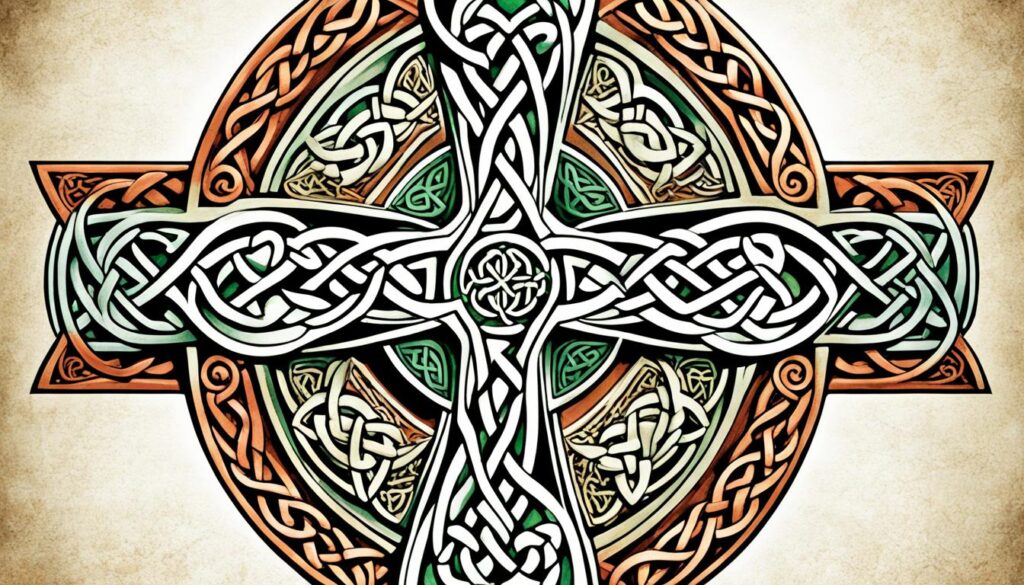 |
Representation of balance, spirituality, and the sun |
| Coptic Cross | 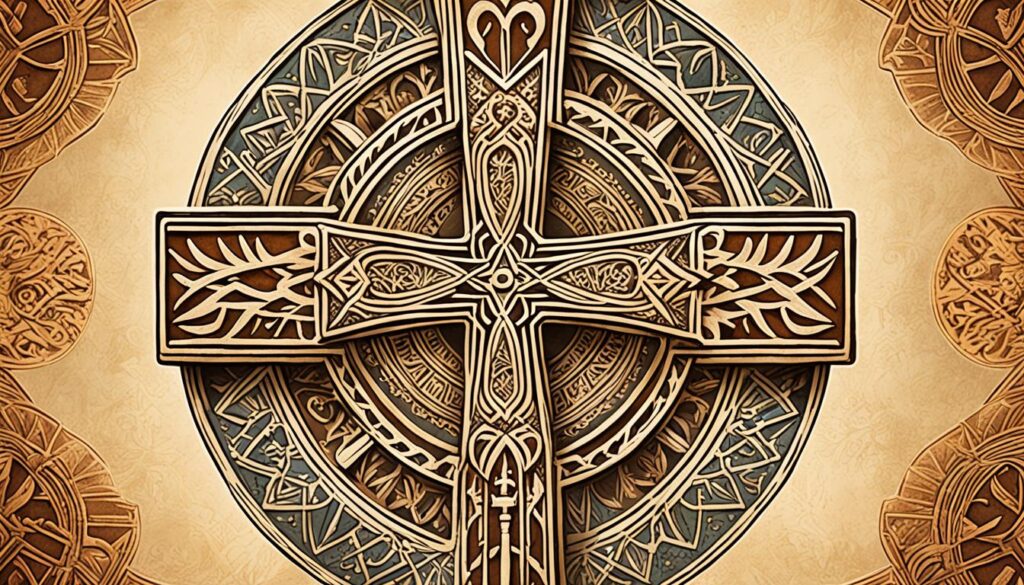 |
Unity of heaven and earth, eternal love |
The table above provides a concise summary of the three types of crosses discussed in this section, highlighting their designs and specific meanings. It is important to remember that while these crosses have cultural and religious associations, their symbolism may vary depending on individual interpretations and traditions.
Symbolism of Cross Variants
Variants of the cross, such as the Russian cross, Jerusalem cross, and Maltese cross, have their own distinct symbolism and cultural significance. Each cross variant carries unique meanings that are deeply rooted in specific religious and cultural contexts.
Russian Cross
The Russian cross, also known as the Orthodox cross, is a prominent symbol in Russian Orthodox Christianity. Its design features three horizontal bars, representing the inscription on the cross of Jesus, INRI. The Russian cross symbolizes the triumph of Christ over death and is a reminder of His sacrifice for humanity.
Jerusalem Cross
The Jerusalem cross, also known as the Crusader’s cross, is comprised of a central cross with four smaller crosses surrounding it. It is associated with the Christian kingdom of Jerusalem during the time of the Crusades. The Jerusalem cross symbolizes the Five Wounds of Christ and represents the spread of Christianity across the five continents.
Maltese Cross
The Maltese cross, also known as the eight-pointed cross, carries great significance in the Maltese culture and the Order of Malta. It is often associated with honor, courage, and nobility. The eight points of the cross represent the eight virtues of the Knights of Malta: loyalty, piety, honesty, dedication, humility, compassion, respect, and perseverance.
Understanding the symbolism of cross variants enables individuals to appreciate the rich cultural and religious heritage associated with each design. Each cross variant serves as a powerful reminder of faith, sacrifice, and the enduring values that have shaped civilizations throughout history.
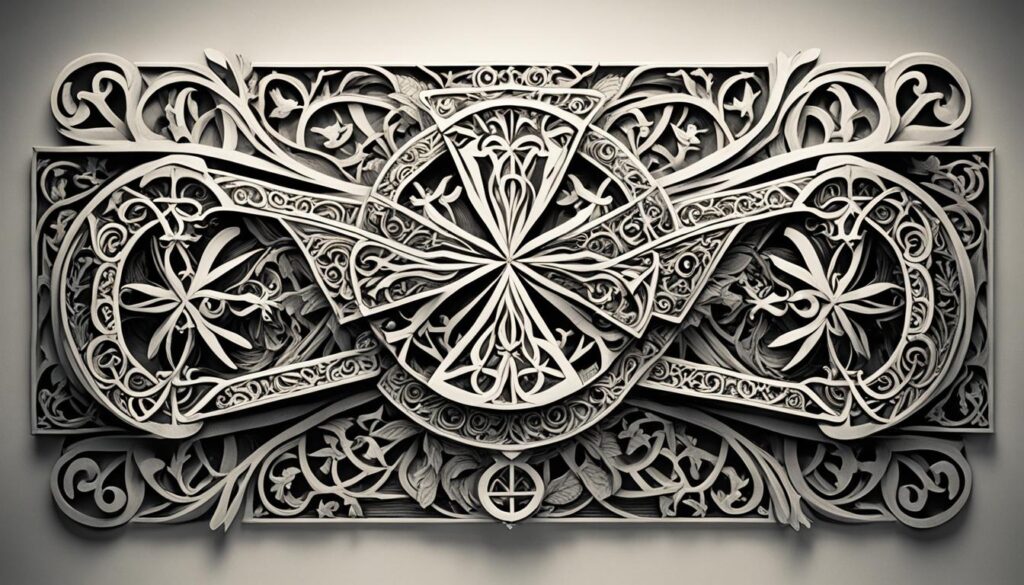
Crosses in Ancient History and Modern Culture
The cross holds a significant place in human history, dating back to ancient civilizations. One of the earliest examples of cross symbolism can be found in Egyptian hieroglyphs, where it is known as the “ankh” or “key of life.” This ancient symbol represented eternal life and was associated with the gods and goddesses of the Egyptian pantheon.
Throughout the centuries, the cross has continued to be a powerful and enduring symbol, transcending time and culture. Its historical significance is rooted in various civilizations and religious traditions, from ancient Egypt to Christianity and beyond.
In modern culture, the cross is still widely recognized and used in a variety of contexts. It remains a prominent religious symbol, representing faith, salvation, and resurrection. Churches and religious institutions often display crosses prominently as a visual representation of their beliefs.
Moreover, the cross has also found its place in fashion and popular culture. It is a popular motif in jewelry design, appearing in necklaces, bracelets, earrings, and rings. The cross’s aesthetic appeal, coupled with its historical and spiritual significance, makes it a timeless and versatile symbol that resonates with people across different walks of life.
“The cross, as a symbol, carries immense historical and spiritual weight. Its presence in ancient history and continued relevance in modern culture speak to its enduring power and symbolism.” – Crosses: An Exploration of Symbolism and Meaning
The Coptic Cross: A Testament of Faith and Identity
In Egypt, the Coptic cross holds special significance. It is a distinct variation of the cross symbol, characterized by its unique design and the presence of additional decorative elements. The Coptic cross is often associated with the Coptic Orthodox Church, one of the oldest Christian denominations in the world.
The Coptic cross serves as a testament of faith and identity for Coptic Christians in Egypt. It is commonly worn as a pendant, displayed in homes, and featured in Coptic artwork and architecture. The cross symbolizes the belief in Christ’s sacrifice and the hope of eternal life.
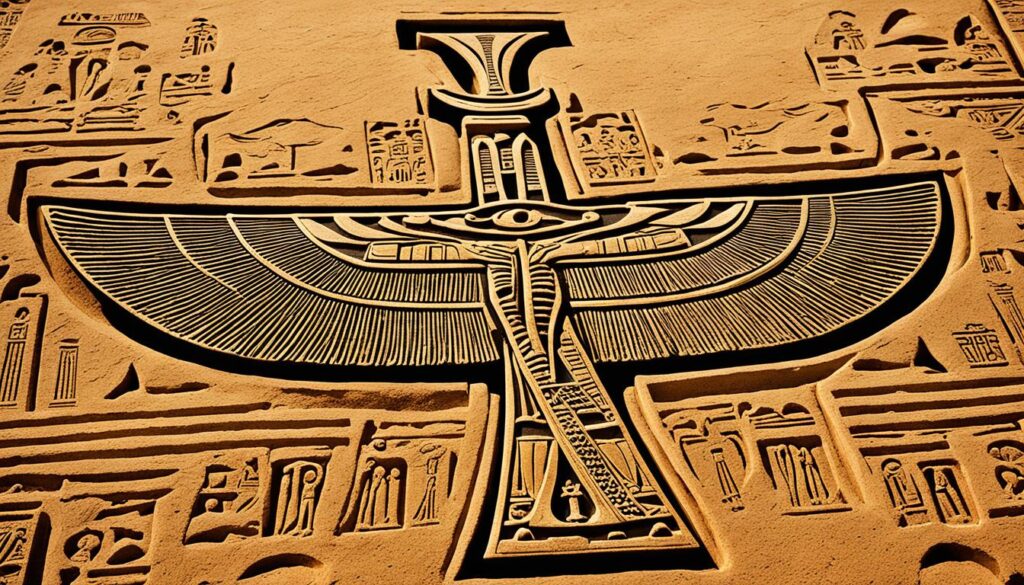
| Ancient History | Modern Culture |
|---|---|
| The cross has been found in ancient Egyptian hieroglyphs, representing the “ankh” or “key of life.” | The cross remains a prominent religious symbol, displayed in churches and worn as jewelry. |
| Ancient civilizations, such as Egypt, used the cross as a symbol of divinity and eternal life. | The cross is a popular motif in fashion, appearing in various forms of jewelry. |
| Crosses held different meanings across cultures, including spiritual, cosmic, and religious interpretations. | Popular culture embraces the cross as a symbol of faith, rebellion, and personal expression. |
Crosses as Personal and Religious Symbols
Crosses hold personal and religious significance for many individuals. They are not only symbols of faith but also carry deep meanings that resonate with people on a personal level. Whether worn as tattoos or pendants, crosses serve as powerful reminders of one’s beliefs and values.
The Meanings Behind Cross Tattoos
When it comes to cross tattoos, the meanings can vary depending on the individual and their cultural or religious background. For some, a cross tattoo represents their Christian faith and serves as a visual display of their commitment to their beliefs. Others may choose a cross tattoo to honor a loved one or symbolize personal growth and transformation. The design, size, and placement of the cross tattoo can also contribute to its unique significance.
“A cross tattoo serves as a daily reminder of my unwavering faith and the strength it gives me to navigate life’s challenges,” says Amanda, a devout Christian.
The Symbolism of Cross Pendants
Cross pendants are a popular form of religious jewelry, worn by people of different faiths around the world. These pendants often carry symbolic meanings that go beyond mere fashion accessories. In Christianity, the cross pendant is a representation of the sacrifice made by Jesus Christ and serves as a constant reminder of His love and redemption. For others, cross pendants may symbolize protection, guidance, or personal connection to a particular saint or religious figure.
“I wear my cross pendant every day as a symbol of my spirituality and as a source of strength and comfort,” shares Michael, a devout Catholic.
The Personal Significance of Crosses
Crosses hold personal significance for individuals on their respective faith and spiritual journeys. They can serve as a source of inspiration, a reminder of moral values, or a symbol of hope and resilience in challenging times. Regardless of religious affiliation, crosses often represent concepts such as love, forgiveness, and the pursuit of a higher purpose.
For many, the personal significance of crosses lies in their ability to offer solace and a sense of belonging. They can provide a connection with something greater than oneself and serve as a tangible representation of one’s relationship with the divine.
Ultimately, whether adorned as tattoos or worn as pendants, crosses carry deep meanings that are as unique as the individuals who cherish them. These symbols of faith and spirituality continue to inspire, comfort, and guide those who embrace their presence in their daily lives.
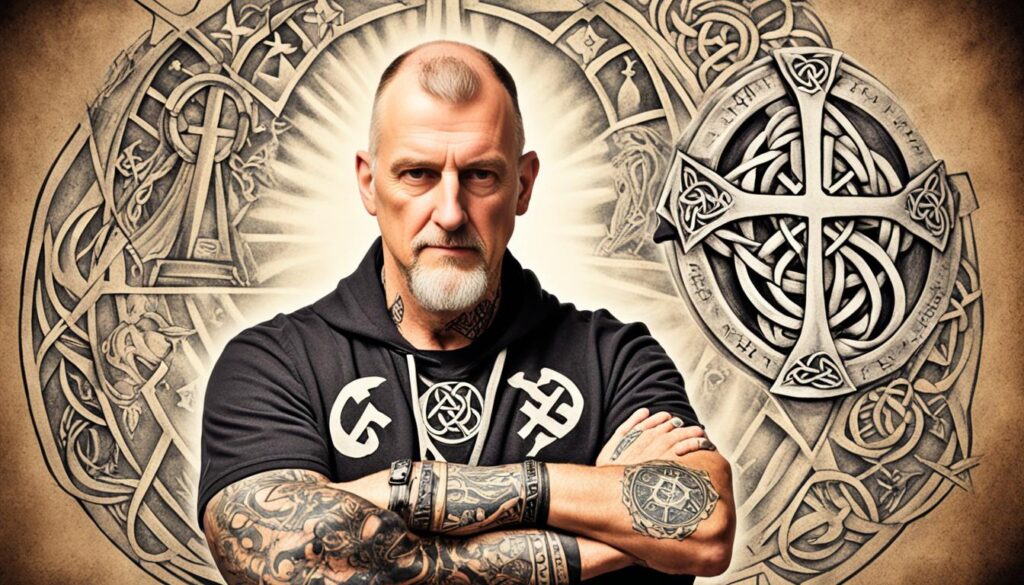
Crosses as Artistic and Decorative Elements
Crosses have long been revered as powerful symbols in Christian art and design. They are not only religious icons but also have deep cultural and spiritual meanings. These cross designs are often incorporated into various forms of art, including paintings, sculptures, stained glass windows, jewelry, and architectural details. The artistic rendering of crosses allows artists to convey Christian symbolism and evoke a sense of devotion, faith, and reverence.
In Christian art, different cross designs hold specific meanings and symbolize various aspects of the Christian faith. The most common cross design is the Latin cross, which consists of a vertical beam intersecting a shorter horizontal beam near the top. This design represents the crucifixion of Jesus Christ and is widely recognized as a symbol of Christianity. The simple yet profound shape of the Latin cross makes it a versatile symbol that can be easily incorporated into various art forms.
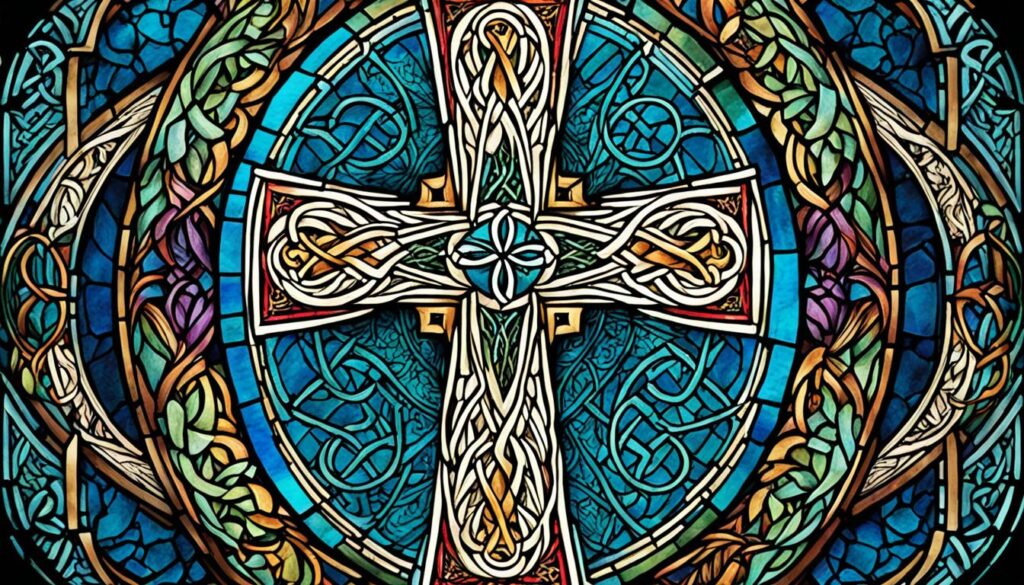
The use of crosses in Christian art goes beyond the traditional Latin cross. Various cross variants, such as the Celtic cross and the Byzantine cross, offer unique designs and additional layers of symbolism. The Celtic cross, with its distinctive circle intersecting the vertical and horizontal beams, represents eternity and the unification of heaven and earth. It is often associated with Celtic Christian traditions and can be seen in intricate stone carvings and illuminated manuscripts.
The Byzantine cross, also known as the Eastern Orthodox cross, has additional arms at the top and bottom, symbolizing the importance of faith in all directions and throughout all creation. This cross design is commonly found in Byzantine religious icons, mosaics, and decorative embellishments in Eastern Orthodox churches.
Christian art also explores the symbolism of crosses through unique artistic interpretations. Artists use color, texture, and composition to convey spiritual concepts and evoke emotional responses. The act of creating art with cross motifs can be seen as an act of devotion and a way to express faith visually.
“The cross is not only a symbol of suffering and sacrifice but also a symbol of hope, redemption, and salvation. It represents the unbreakable bond between God and humanity. Through art, we can explore the profound beauty and significance of the cross, inviting viewers to contemplate its spiritual meaning.”
Christian Symbolism in Cross Designs
Christian symbolism is inherent in cross designs in various ways. The vertical beam of the cross is associated with the divine realm and represents the connection between heaven and earth. It symbolizes God’s love for humanity and the divine presence in our world. The horizontal beam, on the other hand, represents the human realm and symbolizes the unity and reconciliation brought by Jesus Christ’s sacrifice. The intersection of the vertical and horizontal beams signifies the union of divinity and humanity, representing the core belief of Christianity.
Additionally, the cross’s shape and structure offer deeper symbolism. Its symmetry suggests balance and harmony, while the upward movement from the horizontal to the vertical beam signifies spiritual ascension. The cross also reflects themes of self-sacrifice, forgiveness, and the redemptive power of love.
Decorative Use of Crosses
Besides their symbolic significance, crosses are widely used as decorative elements in religious and cultural contexts. They can be found adorning churches, religious artifacts, personal altars, and even clothing and accessories. The ornate detailing and elaborate craftsmanship of cross designs enhance their aesthetic appeal and evoke a sense of reverence and adoration. Crosses can be seen in intricate stained glass windows, delicate engravings on chalices and ciboria, and beautifully crafted pendants and rosaries.
The use of crosses as decorative elements extends beyond religious contexts. They are often incorporated into interior design, fashion, and jewelry as a way to express one’s faith or appreciate the symbolism they represent. Crosses can be found in home decor items, fashion accessories such as necklaces and earrings, and even as tattoos, serving as personal reminders of one’s spirituality and connection to Christian beliefs.
Overall, crosses are not only religious symbols but also powerful artistic and decorative elements. Through different cross designs and their symbolism, artists and artisans continue to create and celebrate expressions of faith, beauty, and devotion across diverse artistic mediums.
Conclusion
In conclusion, the symbolism of crosses holds significant cultural and spiritual meaning transcending time and religious traditions. Crosses symbolize sacrifice, transcendence, humility, love, and heroism. Understanding the spiritual significance of crosses can deepen our understanding of religious symbolism and provide valuable insights into the diverse interpretations and reverence given to this powerful symbol across different cultures and religions.
Throughout history, crosses have been revered and interpreted in various ways, representing the ultimate sacrifice in Christianity and serving as a model for love and heroism. Crosses have been used to bridge the gap between the earthly plane and the realm of spirituality. They have also been embraced as personal symbols of faith and seen as decorative elements in various art forms.
Whether it’s the Latin cross, Celtic cross, Russian cross, or any other cross variant, each carries its own unique meaning and cultural significance. The cross has endured misconceptions and misinterpretations, but its true essence remains rooted in spiritual and religious symbolism.
By exploring the symbolism of crosses and their spiritual significance, we can gain a deeper appreciation for the profound impact this symbol has had on humanity throughout history and continue to honor its enduring presence in our modern culture.
FAQ
What is the significance of crosses in different cultures and religions?
What are some popular types of crosses and their meanings?
What is the significance of cross variants like the Russian cross and Jerusalem cross?
How has the cross been used throughout history and in modern culture?
What do cross tattoos and cross pendants symbolize?
How are crosses used as artistic and decorative elements?
What are some misconceptions and misinterpretations of the cross?
Are Viking Symbols Related to Christian Crosses?
In the decoding Viking symbols tutorial, it is revealed that some Viking symbols are indeed related to Christian crosses. The intertwining of the two cultures can be seen in certain artifacts and carvings, indicating a blending of religious beliefs during the Viking Age.

